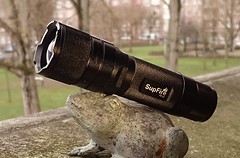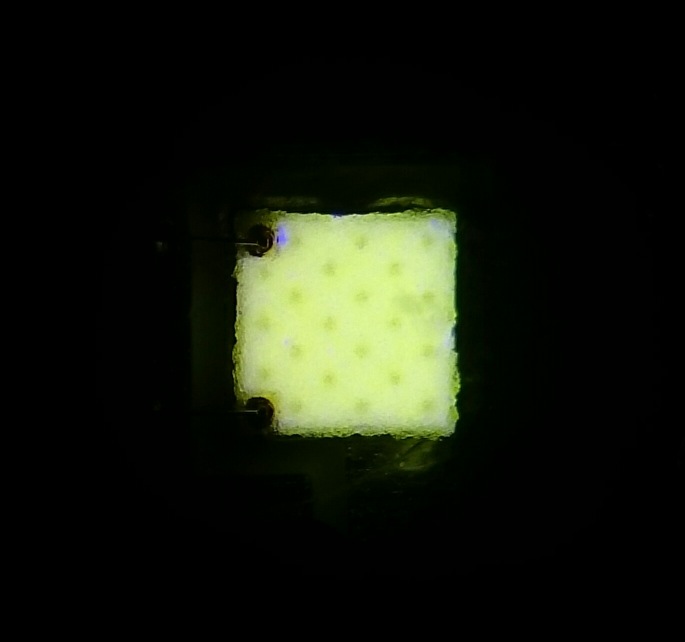I did a test as well :-) let's hope we have similar results. (and welcome to BLF, MEM, it is nice to have another led-tester in the forum, with the bit different test-strategy that you are planning to follow, there's only more insight in the performance of a led !)
I received 6 XP-E2 Torch leds from DBCstm. They are the U5 bin from Mouser (Cree part nr. XPEBTT-01-0000-00Y80), which is the highest bin that Mouser sells and the highest bin according to the datasheet. Why Cree chose the XP-L bin-code (outputs compared at 1050mA) for this led instead of the normal XP bin-code (outputs compared at 350mA) is beyond me! The colour temperature is claimed to be from 6000K to 10,000K (quite a range!), which explains why at least the led I tested does not look all that extremely cool, quite comparable to the XP-E2 R3 1D0 tint from the led I compare it with actually, it must have been closer to 6000K then. First a close look at the leds:
XP-E2 R3 1D0 -> <- XP-E2 Torch U5
<- XP-E2 Torch U5
The package and lay-out looks exactly the same, but the die of the 'Torch' is much rougher/flaky. (the black corner of the Torch led is a marking by me)
I reflowed one of my XP-E2 R3 1D0 leds, and a XP-E2 Torch U5 led on 16mm Noctigons and tested the voltage and led output in my integrating sphere. My methods are explained in detail in the XP-L test thread, with the difference that I used my big integrating sphere instead of the smaller one, but since both are calibrated with the same constant output light source, they should produce the same results.
After testing the leds I dedomed the two leds by heating the boards to reflow temperature on my heat block and then hot-dedome them with a scalpel. I then tested the leds again in the sphere.
The results:

Observations from the graph:
*not only does this XP-E2 Torch led have a (not too dramatic btw) higher output than the tested XP-E2 R3 led, but the maximum output is reached at a bit higher current as well (3.0A as opposed to 2.6A), this is at a higher current than any of the XP-E2 leds that I have tested, none max'ed out at higher than 2.6V. This suggests that the Torch led does not just have a higher output/efficiency, it might also have been structurally changed a bit.
*this Torch led has a maximum output that is 22% more than the led it was tested against, this sounds good, but it might be a bit less promising than it sounds. Comparing the dedomed outputs gives me the opportunity to include four other dedomed XP-E2 R3 1D0 leds that I have recently tested (in the 'cherry-picking' thread). When the best performing led from the five tested is chosen, the Torch does only 14.6% better. And then again, if the XP-E2 bin had been the top R4 instead of the tested R3 bin, that best performing XP-E2 could have been 6% brighter even, and compared with that best performing from the best bin conventional XP-E2 there is only 7.2% improvement leftover that this Torch led provides, this would just be about one bin-number up: R5. (this is not completely fair, I should have 'cherry picked' my Torch led as well for this logic).
*the Torch led has a 0.8V higher voltage than the tested XP-E2 R3 led, but that is within the variation that exists within XP-E2 leds, i.e. the best tested led nr. 3 in the cherry-picking thread is only 0.3V lower than the Torch.
*a general observation: dedoming in these two leds caused a 9.2% and 9.3% decrease in light output resp., with no voltage changes. I tested a XM-L2 T6 3C domed and dedomed a while ago and dedoming caused 9.1% decrease in light output with again no voltage change. These numbers are very consistent while I have heard rumours before of 20% light loss and noticable voltage changes, upon dedoming.
Conclusion
I only tested one 'Torch' led, but it seems like this led is not the led with the dramatically improved surface brightness that I long for. Let's be gentle to Cree and say that it is about 10% brighter than the best bin XP-E2 around already.
On the other hand, I feared for an ugly extreme cool white tint but at least the XP-E2 Torch that I tested had a very bearable tint, not much above 6000K, and dedomed I (me=highCRI-snob) would call the tint actually pleasant :-) So in this perspective, the XP-E2 Torch is a fair upgrade for who wants cool and bright!
Mod

In the XP-E2 cherry picking thread I used the best of four tested dedomed XP-E2 R3 1D0 leds for a Supfire F3 zoomie build, and measured the throw to be 96 klux@1meter. This Torch led should do it a bit better, and because I was modding another F3 for a BLF-member anyway, I could use this led (he will not mind  ) and see the improvement in a real flashlight. So I did the exact same mod again (Supfire F3, 6x7135 AK-47-A driver, XP-E2 Torch led, cosmetic blackening of the board mounting ring and led). The driver of the second mod provided 2.07A current, while the first mod did 2.10A (there's some variation in 7135 chips). My measurements say that the led in the first mod at 2.10A produces 452 lumen, the Torch led in the second mod at 2.07A produces 491 lumen, so with the first mod producing 96klux@1meter throw, the second mod should produce 104 klux@1meter.
) and see the improvement in a real flashlight. So I did the exact same mod again (Supfire F3, 6x7135 AK-47-A driver, XP-E2 Torch led, cosmetic blackening of the board mounting ring and led). The driver of the second mod provided 2.07A current, while the first mod did 2.10A (there's some variation in 7135 chips). My measurements say that the led in the first mod at 2.10A produces 452 lumen, the Torch led in the second mod at 2.07A produces 491 lumen, so with the first mod producing 96klux@1meter throw, the second mod should produce 104 klux@1meter.
Well, I measured 107 klux@1meter in the actual flashlight, that is close enough :-)



![]()
![]()
 <- XP-E2 Torch U5
<- XP-E2 Torch U5

 ) and see the improvement in a real flashlight. So I did the exact same mod again (Supfire F3, 6x7135 AK-47-A driver, XP-E2 Torch led, cosmetic blackening of the board mounting ring and led). The driver of the second mod provided 2.07A current, while the first mod did 2.10A (there's some variation in 7135 chips). My measurements say that the led in the first mod at 2.10A produces 452 lumen, the Torch led in the second mod at 2.07A produces 491 lumen, so with the first mod producing 96klux@1meter throw, the second mod should produce 104 klux@1meter.
) and see the improvement in a real flashlight. So I did the exact same mod again (Supfire F3, 6x7135 AK-47-A driver, XP-E2 Torch led, cosmetic blackening of the board mounting ring and led). The driver of the second mod provided 2.07A current, while the first mod did 2.10A (there's some variation in 7135 chips). My measurements say that the led in the first mod at 2.10A produces 452 lumen, the Torch led in the second mod at 2.07A produces 491 lumen, so with the first mod producing 96klux@1meter throw, the second mod should produce 104 klux@1meter.


 : zoomed out: 290 lumen, zoomed in 95 lumen (long focal length lenses like in this zoomie give narrow hotspots and big differences between zoomed in and zoomed out)
: zoomed out: 290 lumen, zoomed in 95 lumen (long focal length lenses like in this zoomie give narrow hotspots and big differences between zoomed in and zoomed out) . I always use klux@1meter because that is how I measure it: I measure the klux@5meter and calculate back what it is at 1meter (times 25). klux@1meter is a sort of standard way to represent throw.
. I always use klux@1meter because that is how I measure it: I measure the klux@5meter and calculate back what it is at 1meter (times 25). klux@1meter is a sort of standard way to represent throw.